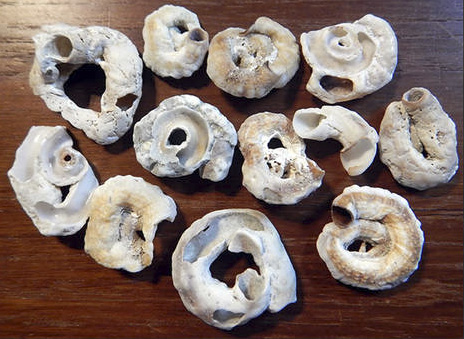Published in the Ocean Watch column, Honolulu Star-Advertiser © Susan Scott
April 6, 2019
While walking along a North Shore beach last weekend, I picked up several broken worm snail shells that had washed ashore during the high surf. These shell shapes are so different from the usual ones that most people don’t recognize them as snail shells.
Because algae and other encrusting organisms often grow on them even when they are still alive on the reef, they can easily go unnoticed by snorkelers and divers.
My worm snail shells were still rattling around in my pocket when I sat down to my check my email. And as if these creatures were begging to be noticed, a reader had sent a note asking to identify the “doodles” she found on the beach. The photo she had attached showed two worm snail shells.
 Shells of worm snails,
Shells of worm snails,
also known as vermetids, from a Waialua beach.
©2019 Susan Scott
Doodles is an apt name. Although some species grow stretched out, most grow in spirals.
As larvae the creatures drift in the plankton until they reach the stage where it’s time to settle down. In a phenomenon known as founder effect, mature worm snails release a chemical that tells youngsters the location of an established colony. Sometimes, though, the kid is on its own and must start its adult life alone in a new place. Soon that snail will send out its own homing signal.
Worm snails thrive in tropical waters from tide pools to about 40 feet deep. Adults spend their lives in self-made calcium carbonate tubes that, like a barnacle, it glues to rocks, concrete pilings or other solid surfaces.
Some people call these mollusks tube snails, but since the reef also hosts abundant species of tube worms, this name is confusing. The scientific family name for worm snails is Vermedtidae, “verm” being Latin for worm. A vermetid, as these snails are also called, is not a worm, but a mollusk.
The body of the worm snail inhabits the open end of the spiral shell, building it in sections either squiggly or straight, depending on the species, shape of the rock and water conditions. The more shell the snail lays down, the better it can stay attached in wave-washed areas. The mollusk seals off its rear chambers with calcium carbonate plugs as it grows.
Most snails roam the reef on a muscular foot to find food, but the sedentary worm snail casts out nets, or veils, of mucus. Glands in its foot manufacture the mucus, releasing it via tiny tentacles. Waves and currents spread the sticky stuff over the rock; some nets reach as far as 20 inches.
When the net, visible at the snail’s open end, catches plankton, the snail hauls it in, eats it and builds a new net. In one study of a Red Sea worm snail, it took two minutes for the animal to haul in its food net, and did so every 13 minutes.
Hawaii hosts eight worm snail species. When they die or waves dislodge them from their rocks, the hollow white shells wash up on the beach. During high surf, some of us then walk the beach with a pocketful of doodles.